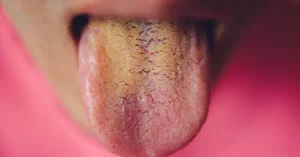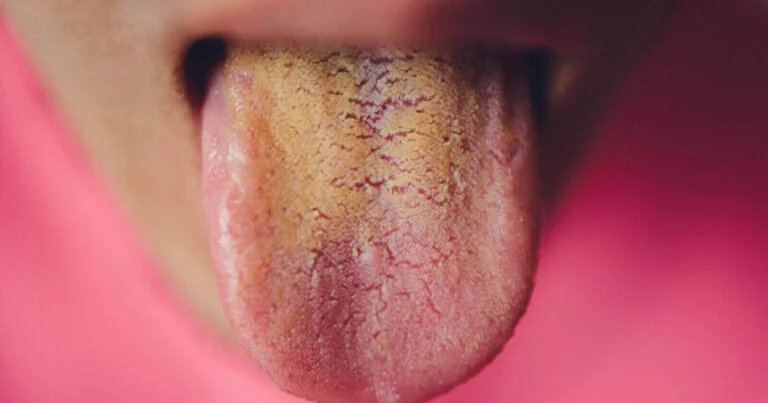A yellow tongue may not seem like a huge concern, but it could mean that you have health problems that need to be fixed. You might not know it, but the color of your tongue can tell you a lot about your health. A yellow tongue is usually not a significant concern and is caused by things like what you eat or a short-term illness. But if your tongue stays yellow for a long time, it could signal that something worse is going on. Here are five health issues that might cause your tongue to look yellow, along with their symptoms, risk factors, and what you can do about them.
One of the most prevalent medical causes is oral thrush, which is a type of yeast infection that happens when the fungus Candida albicans grows too much in the mouth. There are small amounts of this fungus in our mouths all the time, but some things can make it grow too much. People who have a weak immune system, are taking antibiotics, or have diabetes that isn’t under control are more likely to have thrush.
When thrush affects the tongue, it might look like a thick yellow or white layer on top of it. It can also make your mouth feel like it’s full of cotton, hurt, make it hard to swallow, and give you terrible breath. It can also spread to the esophagus and gums if you don’t treat it. Doctors often use antifungal drugs to treat oral thrush. But good dental hygiene, such brushing your tongue every day and rinsing your mouth after taking antibiotics or inhalers, can help keep it from occurring in the first place.

Another reason for a yellow tongue is gastroesophageal reflux disease (GERD). GERD occurs when stomach acid often flows back into the esophagus and sometimes even into the mouth. This acid can make the soft tissues in the mouth and tongue hot and hurt, which can change their color. People with GERD may also have a bad taste in their mouth, heartburn all the time, bad breath, and even lose teeth over time.
Overeating, eating late at night, eating acidic or spicy foods, smoking, being overweight, and being under a lot of stress all raise the risk of GERD. Doctors often suggest changes to your lifestyle to aid with GERD and lessen symptoms like a yellow tongue. Some of these changes are eating smaller meals, avoiding things that make it worse, not lying down right after eating, and sleeping with your head raised. Sometimes, medicine is needed to help the stomach create less acid.
Yellow tongue can also be caused by jaundice, which is more serious but less common. When red blood cells break down, they create a yellow pigment called bilirubin. It might not be able to break it down and get rid of it if the liver isn’t performing well. The skin, eyes, and tongue might turn yellow if there is too much bilirubin in the body. Jaundice isn’t a disease; it’s an indication of something else.
It can happen because of hepatitis, fatty liver disease, a blocked bile duct, or drinking too much for a long time. People with jaundice may also feel tired and ill, have pale poop, black pee, and stomach pain. If you observe these symptoms, you should see a doctor right away since jaundice could suggest that your liver isn’t operating normally. Doctors often utilize imaging and liver function tests to figure out what’s wrong, and the treatment depends on what’s wrong.
A common reason of yellow tongue that people don’t often think about is too many bacteria. People can have this ailment if they don’t take care of their teeth and gums. The tiny papillae on the tongue’s surface can hang onto pieces of food, dead cells, and bacteria. If you don’t clean these often, they might get dirty and smell terrible. They can also turn yellow or brown.
People who smoke, chew tobacco, drink too much coffee or tea, or don’t drink enough water are more likely to do this. If your tongue has a yellow film on it and you don’t have any other symptoms, it usually signifies you aren’t brushing or scraping it well enough. The answer is simple and works: brush your tongue every day, drink more water to stay hydrated, and stay away from tobacco and foods and drinks that stain. Antibacterial mouthwashes can also help keep the top of your tongue clean.
Finally, postnasal drip from respiratory diseases including the common cold, sinus infections, or tonsillitis can make your tongue yellow. Mucus from the sinuses or nasal passages can drop down into the mouth and cover the tongue, which can change its appearance. This happens more commonly when you have the flu or when your immune system isn’t working well. Along with the yellow coating, you can also experience a sore throat, cough, stuffy nose, or swollen lymph nodes. In these cases, the discoloration usually goes away once the infection that caused it is treated. Drinking a lot of fluids, gargling with salt water, and breathing in steam will assist with symptoms and get rid of mucus.
Most of the time, a yellow tongue isn’t hazardous and fades away on its own. But there are times when you should pay attention to it. You should see a doctor right away if the yellow covering lasts for longer than two weeks. If you also have pain, a fever, difficulties swallowing, or yellowing of the skin or eyes, this is especially true. These could be signs of a more serious illness, including liver disease or a systemic infection.
Keeping your mouth clean is one of the easiest and best strategies to avoid yellow tongue. Brush your teeth and tongue twice a day, floss every day, drink a lot of water, don’t smoke, and don’t eat or drink too much alcohol or food that is too colorful. These small actions you do every day can actually help keep your mouth and body healthy.
